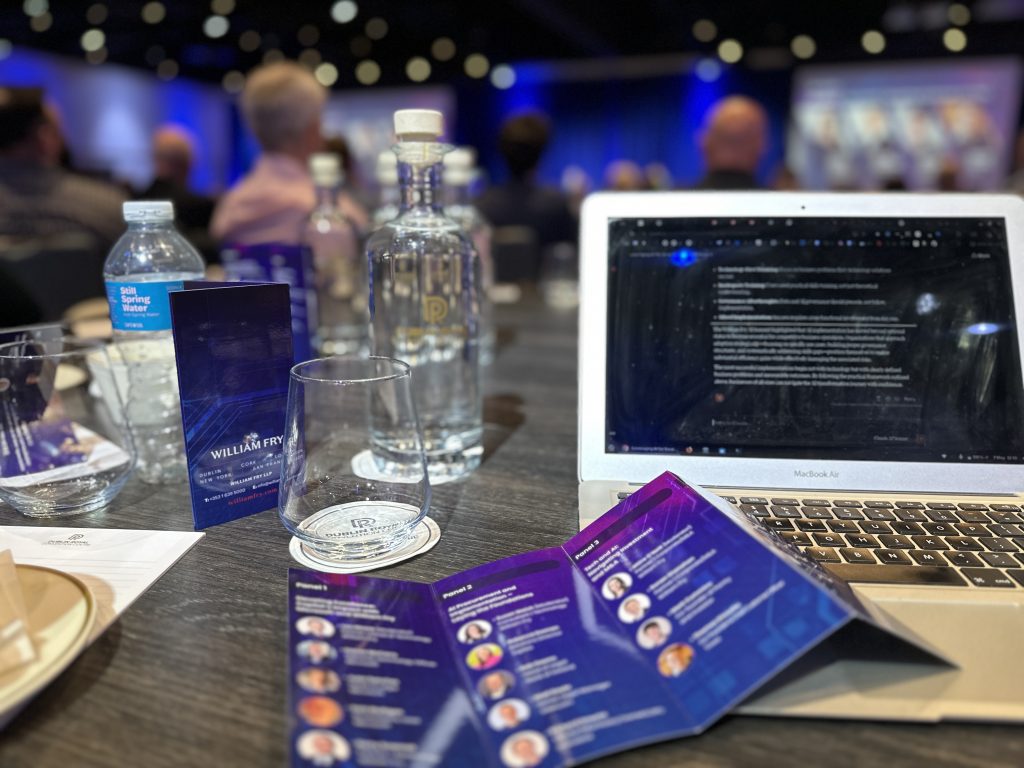Research shows generative AI adoption in Ireland more than doubled – from 49% to 91% – in just 12 months. Here’s what smart businesses are doing next.
That kind of growth doesn’t happen by chance. It signals a turning point: AI has moved from an emerging technology to an operational must-have.

At William Fry’s 2025 AI Summit in Dublin, leaders from Microsoft and William Fry shared what’s working in real-world business environments.
AI is Now a Business Essential
Irish organisations have gone from cautious to committed.
In just a year, enterprise AI usage has exploded. Businesses that were once testing tools are now embedding them into daily operations.
Why this matters:
➡️ Falling behind is now a real risk
➡️ AI is driving measurable efficiency gains
➡️ The tools are ready – the challenge is implementation
The Benefits Are Tangible
Firms adopting enterprise AI are seeing clear returns:
- Saving 2–4 hours per employee per week
- Shifting the workload from admin-heavy to high-value
- Improving consistency and cutting errors
- Speeding up work without sacrificing quality
Those time savings add up fast across large teams. And the work people do feels more meaningful when repetitive tasks are off their plates.
What Works in Real Implementation
A phased rollout beats big bang every time.
Here’s the approach that’s proving successful in large organisations:
1. Start Small and Targeted
- ➡️ Pick clear use cases with measurable outcomes
- ➡️ Run cross-functional pilot projects
- ➡️ Track time savings and error rates
- ➡️ Use early wins to build internal support
2. Scale With Intention
- ➡️ Focus on areas with clear ROI
- ➡️ Build internal champions across departments
- ➡️ Create feedback loops for ongoing improvement
- ➡️ Set up a centre of excellence to share knowledge
High-Impact Use Cases
These are the areas where AI is already making a difference:
➡️ Document drafting and review
Improves consistency, reduces editing time, and frees teams to focus on substance.
➡️ Workflow automation
From email generation to onboarding follow-ups, AI is simplifying time-heavy processes.
➡️ Knowledge access
AI-powered search cuts onboarding time and preserves institutional knowledge.
This is important because each of these use cases connects directly to business outcomes – time saved, errors reduced, and faster decision-making.
Challenges You’ll Need to Tackle
1. Closing the Skills Gap
Many teams aren’t AI-ready, but you don’t need experts everywhere.
What works:
- Tiered AI training for different roles
- Cross-functional implementation teams
- Clear, practical learning – not just theory
- Support from external partners early on
(If you need help with AI training, reach out)
2. Managing Shadow AI
If you lock tools down too tightly, people will work around you.
That opens up real data security risks.
Instead:
- Set permissive, structured AI policies
- Use enterprise-grade tools with proper controls
- Make security and compliance non-negotiable
3. Laying the Data Groundwork
AI needs clean, accessible data.
That means:
- Running a data inventory
- Mapping sensitive data
- Tightening access controls
- Monitoring how data flows in your systems
This groundwork isn’t optional. It’s the backbone of safe, effective AI use.
Legal & Compliance: What to Know Now
Regulators are paying attention.
Organisations need to show:
- Documented AI training for staff
- Protocols to verify AI-generated content
- Transparent handling of personal data
- EU-based data processing where possible
This is important because compliance won’t wait for you to catch up. Build it into your implementation plan from day one.
What’s Next: Trends to Watch
Agentic AI
AI agents that handle multi-step tasks across systems are on the horizon. Think research, procurement, or legal analysis – automated end-to-end.
Stronger Enterprise Commitments
Big providers are now offering:
- Local cloud infrastructure
- Resilience and uptime guarantees
- Clearer privacy and data safeguards
- Better support for open-source tooling
Implementation Roadmap: A Strategic 90-Day Action Plan
Rolling out AI successfully takes more than just enthusiasm and tools—it needs a clear structure and steady pace. This 90-day plan is based on the framework I share in the “AI Adoption Roadmap” (part of the full AI Toolkit at humanspark.ai/toolkit). It gives you a practical way to start small, build momentum, and scale with confidence.
Days 1–30: Assessment & Preparation
- Run a team survey
Capture where people stand on AI—what excites them, what worries them, and what they’re already trying. It’ll highlight quick wins and deeper gaps. - Pick your AI champions
Find curious, respected people across departments who can lead by example. They’ll be key to encouraging adoption from the ground up. - Deliver hands-on training
Give your champions practical, no-jargon sessions on AI basics, ethical use, and useful applications. Focus on real work problems, not just theory.
Days 31–60: Building Momentum
- Set up an AI working group
Bring together IT, ops, legal, HR, and leadership. This group will set policy, track progress, and help avoid siloed efforts. - Create an AI sandbox
Let teams explore AI tools safely using synthetic or non-sensitive data. Keep it separate from live systems, with clear guidelines for testing. - Launch quick-win projects
Start 2–3 small, low-risk pilots with obvious benefits—like time saved or tasks automated. These early wins are crucial for buy-in.
Days 61–90: Expanding Capability
- Draft usage policies
Define how AI should (and shouldn’t) be used. Balance control with flexibility. Make sure your policies support innovation, not block it. - Expand smartly
Roll out the best pilots to more teams—but don’t skip the governance. Use what you’ve learned to improve the next phase. - Capture lessons learned
Start documenting insights, risks, and best practices. A shared knowledge base helps teams avoid reinventing the wheel.
Beyond 90 Days: Strategic Transformation
- Scale with purpose
Focus on use cases aligned with business goals. Don’t chase every trend—build on what’s working. - Strengthen your foundations
Invest in scalable data systems and clear governance. These are the guardrails that’ll support long-term growth. - Embed it culturally
Make AI part of how you work and make decisions. It’s not just a tool—it’s a shift in how teams think and operate.
This roadmap supports responsible AI rollout that delivers real business value—while also improving how teams work.
For more detailed guidance and templates, you can find the full toolkit at humanspark.ai/toolkit.
Success Factors: What Makes AI Stick
- Start with the data
Poor data equals poor AI performance. - Engage your frontline
They know what’s slowing them down. - Measure real outcomes
Focus on time saved or errors reduced – not just “adoption.” - Get outside help early
Internal teams don’t need to figure it all out alone. - Build a community inside
Champions across departments drive sustained use.
Pitfalls to Avoid
- Endless pilots with no follow-through
- Letting the tech lead instead of the business case
- Training that’s too abstract or too light
- Treating governance as an afterthought
- Keeping AI siloed in IT or innovation teams
Final Thought
AI is no longer about the future. It’s about your next 90 days.
The best implementations start by solving real business problems – not by chasing shiny tools.
Get the basics right. Involve the right people. Measure what matters.
That’s how you make AI deliver for your business.
What use case could AI help with in your team?
I’d love to hear where you’re starting – or where you’re stuck. I posted about this on LinkedIn – please leave your thoughts on the post there, and I’d love to connect there.
PS: Thanks to the William Fry team for a really practical look at how enterprise AI is evolving.




